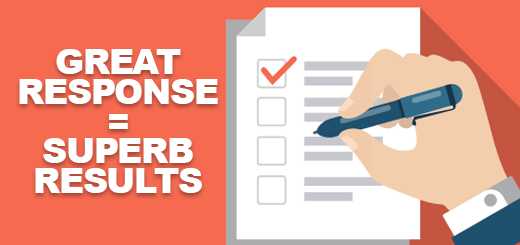
When you want to improve your business, you need to know where changes have to take place. It could be upgrading your products/services, implementing more efficient processes, providing more training to your staff, or a hundred other improvements.
But what’s the best way to figure out which changes you need to make? Getting feedback from your customers and prospects — with a survey.
If you do it right, a survey can give you plenty of information — some of which can be truly surprising — in order to make positive changes.
But if you do it wrong, you’ll get unusable data and potentially annoy (or even anger) your audience.
Creating your survey
It’s vital to focus on the entire survey experience. After all, you want your respondents to accomplish two tasks:
- complete the whole survey; and
- give you honest, clear and specific feedback.
Here are some ideas for creating a survey that will keep your audience engaged — while ensuring that you get the actionable responses you need:
- Give them a “why.” Put yourself in their shoes for a moment. Would you want to fill out a survey sent by your company? Do you want to take the time out of your day?Basically, you’re counting on them to be nice and generous with their time. So tell them why you need their feedback, what you’re hoping to do with it, and why they should care at all.Let them know that their responses will help you serve their needs better, and that they have a say in the future of your company.
- Let them know what they’re in for. You’ve probably taken a survey that seemed to go on and on — so long that you start to think about quitting (or you just quit because you’ve got better things to do.Don’t be that surveyor! Tell your audience about how long it will take to complete your survey — this will reduce the number of people who either rush through it or quit in the middle.Some surveys include a progress bar, which can serve as an encouragement along the way. When the bar says they’re 50% complete, it’s like saying “You’re halfway done!”And there’s no rule that says you can’t put messages like that right in your survey — like “Just two questions to go!”
- Write the survey in your “voice.” A little personality goes a long way — so don’t be too formal or boring. Your survey should be engaging to the point where respondents are motivated to give you constructive input.Write the survey the same way you’d have a conversation with them — as if you were chatting over coffee. Thank them in advance for their time and their complete, honest answers. And offer some helpful words if you’ve asked something complicated, or for an open-ended response.The friendlier and more encouraging you are, the more likely they are to complete the survey and provide you with valuable feedback.
- Give them the chance to be heard. It’s definitely worthwhile to ask some questions that give your respondents the opportunity to give a longer answer. They may not want to — in fact, you ought to assume they won’t — but if they’re motivated to provide additional feedback, you should encourage it.So at the end of your survey, thank them for completing it and remind them how much their input means to you — and how you’ll be using their answers to improve the customer experience.A quick “If you’d like to share any other opinions or advice, please type your response in the box below” might just provide you with a great insight into improving a part of your business. And even if they don’t respond, they’ll probably appreciate that you made the offer and were interested in whatever it is they might want to share.
- Be the first respondent. Done creating the survey? Take a break — you deserve it! Go get some fresh air, pour yourself a fresh cup of coffee (for the antioxidants!), and sit back down to take the survey yourself.Some great reasons to do so:
— Make sure you’ve given people a compelling reason to fill it out.
— Ask yourself if you REALLY think your target audience will complete the whole thing.
— Check to see that every single question is necessary — and worded correctly, too.
— Confirm that you’ve made it easy to read, understand and complete.
- Post-survey: Share with your respondents. After you’ve received your responses (oh, did we mention you should put a “Please complete this survey by [DATE]” note at the end?), you’ll have plenty of raw data and results. (Letting respondents know that they’ll get to see the results is one more motivation for them to complete your survey.)As long as you don’t share any personal identification information, feel free to share the raw results with your respondents. Anyone who completes the entire survey will certainly be interested in what others have to say.And later, once you’ve completed analyzing the results, go back to your respondents and explain what you did with their feedback. This will make them feel heard, appreciated and empowered, especially since it’s usually (and unfortunately) rare for companies to go to those lengths.Plus, they’ll be much more likely to participate in your next survey — and even share the news of their experience with friends and colleagues.
If you put all of these tips into action when creating your next survey, we’re confident that you’ll get a strong number of responses, well-thought-out feedback, and superb results that you were hoping for!
Do you have any tried-and-true tips for better surveys? Share your ideas in the Comments below!
